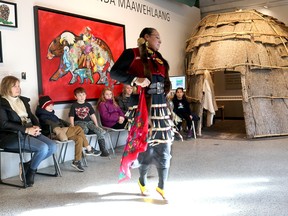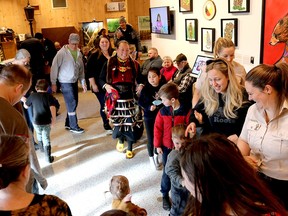
Lorna Chrysler, of the Chippewa of the Thames First Nation near London, has been dancing since she could walk.
Advertisement 2
Article content
On Saturday, she shared her knowledge of traditional Indigenous dancing with many non-Indigenous people who took the opportunity to learn a few steps during a gathering of cultures event at the Rondeau Provincial Park visitor center.
Article content
“The turnout was amazing,” Chrysler said, adding she was happy to see so many families out enjoying the day.
She talked about the various dances, such as the side-step and the round dance and how some dances mimic birds and animals.
Chrysler said she has noticed an increase in non-Indigenous people wanting to learn more about Indigenous culture.
“I think it’s really important just to have that awareness.”
Jess Matthews, chief park naturalists at Rondeau, said the gathering cultures project began about six years ago, after she arrived seven years ago saw there wasn’t any Indigenous content, “which just didn’t sit well with me, personally.”
Advertisement 3
Article content
She said having a Family Day weekend event was seen as a nice way to get people into the park during the winter.
“This really warms my heart,” Matthews said of the people who packed into the visitor center to watch and join Chrysler as she taught them some dances.
She said park staff has been working hard to gather communities so people can experience something new.
Alishia Thompson and her one-year-old daughter Gray were among those that enjoyed Saturday’s event.
“We had a really good time immersing ourselves in this culture,” Thompson said. “We partake in as much as we can here.”
She added it was interesting to hear what Chrysler had to say about the dances.
Chrysler said numerous powwows are held across the region throughout the summer that non-Indigenous people are welcome to attend.
Advertisement 4
Article content
“It’s more of a social gathering, so that way everyone can come out and have a taste of the culture,” she said.
She said there are intertribal portions of the powwow which is a welcoming for everyone to join in and dance.
She added some competitive powwows have contests for non-Indigenous people to dance and “do their thing. It’s really fun.”

Matthews said, “Ontario Parks, in general, is working really hard to incorporate more Indigenous knowledge and Indigenous teachings and collaboration into all of our provincial parks.”
Rondeau has definitely been at the forefront of this effort, she said, adding the park has worked with a number of Indigenous communities in the region to try to get different styles of art and dance shown at the visitor center.
She noted Aamjiwnaang First Nation artist John Williams was doing his fourth workshop of the year on Saturday.
Other community members from Caldwell First Nation and Eelünaapéewi Lahkéewiit – Delaware Nation at Moraviantown, also come to the park to share their culture at other times throughout the year.
“The traditional guided hikes and nature talks. . . are very important and people love coming for that,” Matthews said.
She added the gathering of cultures is “something that’s different and maybe new to some people and it is one of the most important things that we do here at the park.”
Article content
